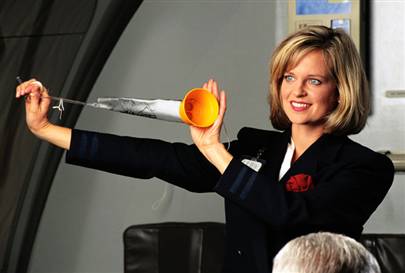Aviation Safety & Unrealistic Expectations
By Scott Spangler on March 24th, 2014Has the exemplary aviation safety record become its own worst enemy because it instills unrealistic expectations of risk in the minds of those fly? As a consequence, reactions to these infrequent but unpreventable circumstances instantly climbs to a level above and beyond hyperbole.
 We all know that complacency in pilots can lead to unfortunate outcomes. But what about passengers? Do the years that often separate fatal airline and business aviation accidents build a sense of risk complacency in their minds? Do they think “It can’t happen to me.”?
We all know that complacency in pilots can lead to unfortunate outcomes. But what about passengers? Do the years that often separate fatal airline and business aviation accidents build a sense of risk complacency in their minds? Do they think “It can’t happen to me.”?
And what about passengers in general aviation airplanes flown for fun and/or personal business? Do they harbor delusions of risk-free flight? Do they consciously acknowledge the risk they assume when they fasten their seat belts, like those who must read the mandatory passenger warning in amateur-built experimental aircraft: This aircraft is amateur built and does not comply with the federal safety regulations for standard aircraft.
Some might say that a realistic understanding of the risks involved with flying would be bad for business. This might be true for the media, which reaps the financial rewards of higher ratings by force feeding questionable “news” to an audience that can’t turn away (or turn off) the spectacle. But if the automobile industry is any clue, a more realistic grasp on the risks involved wouldn’t hurt aviation.
Vehicular accidents are so common that to make the news they must be spectacular and involve large numbers and, this winter, large trucks. Most people, I think, understand and accept this risk, and adjust their plans and routes accordingly.
 Others might suggest that the safety briefing performed before takeoff by the cabin crew is the connection to the reality of aviation’s risks. Maybe. But how many passengers pay attention? It is not a participatory event like the abandon ship and life boat drills that starts the cruise on some floating city. Nothing makes the point of assumed risk more real than putting on a bulky life jacket, traversing a maze of passageways in quick, anxious steps, and wondering if your face wears the same nervous smile you see on the faces in your lifeboat line.
Others might suggest that the safety briefing performed before takeoff by the cabin crew is the connection to the reality of aviation’s risks. Maybe. But how many passengers pay attention? It is not a participatory event like the abandon ship and life boat drills that starts the cruise on some floating city. Nothing makes the point of assumed risk more real than putting on a bulky life jacket, traversing a maze of passageways in quick, anxious steps, and wondering if your face wears the same nervous smile you see on the faces in your lifeboat line.
That brings me to our current aviation mystery, Malaysian Flight 370. It’s not the first airplane to go missing, as Amelia Earhart would surely agree, but the people of her day had a more realistic view of aviation’s inherent risks than we do today.
Technology has certainly played a role in this change, and that inspires my last question: Why aren’t commercial aircraft equipped with emergency position indicating radio beacons (EPRIBs)? Ships have them, and where they can disappear covers less area that an airplane’s final resting place. Airplanes operate in an environment that covers the entire globe, and then they fall to a surface that’s three-quarters wet. –Scott Spangler, Editor
Related Posts:







March 25th, 2014 at 1:39 pm
You point out something that seems to be lost on the half a dozen or so startups who are going to market with products that attempt to circumvent the rules against Pilots “holding out” to the public, and not sharing “common purpose,” with their passengers, essentially trying to turn private flights into grey market air carriers.
I’m not against innovation, but rules are rules.
March 27th, 2014 at 5:04 am
Maybe EPRIBs are not used simply because they have as much chance to be destroyed or unreachable as a FDR or CVR… (which is not the case for a big ship, and furthermore, said ship is slow and sinks relatively slowly as well)
Think Rio – Paris Air France flight here…
Even when knowing where hte crash occured, finding those boxes proved hard. So if you think it backwards : if you can hardly find such boxes, why bother install them ?
April 1st, 2014 at 5:59 pm
Scott,
Thanks for a good post. I agree with your underlying point, but think the problem is larger than aviation. In most of society people no longer understand the concept of a calculated risk. Even the word ‘safe’ has little meaning. There are almost no activities that have zero risk. Risk needs to be analyzed, mitigated, managed, and then a risk-reward decision made to decide if an operation should be undertaken. This can be flying a small aircraft, riding on an airliner, or crossing a street. Almost nothing is truly ‘safe,’ but instead we decide to take actions after deciding that the benefits outweigh the risks.
Greg Morris
Gauntlet Warbirds
http://www.gauntletwarbirds.com
May 23rd, 2014 at 6:04 am
What ever happened to ADS/B?